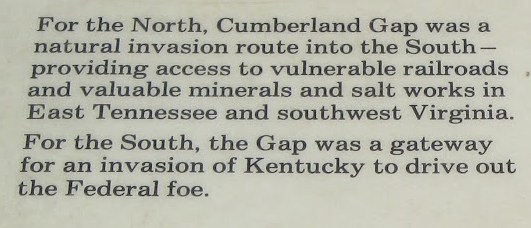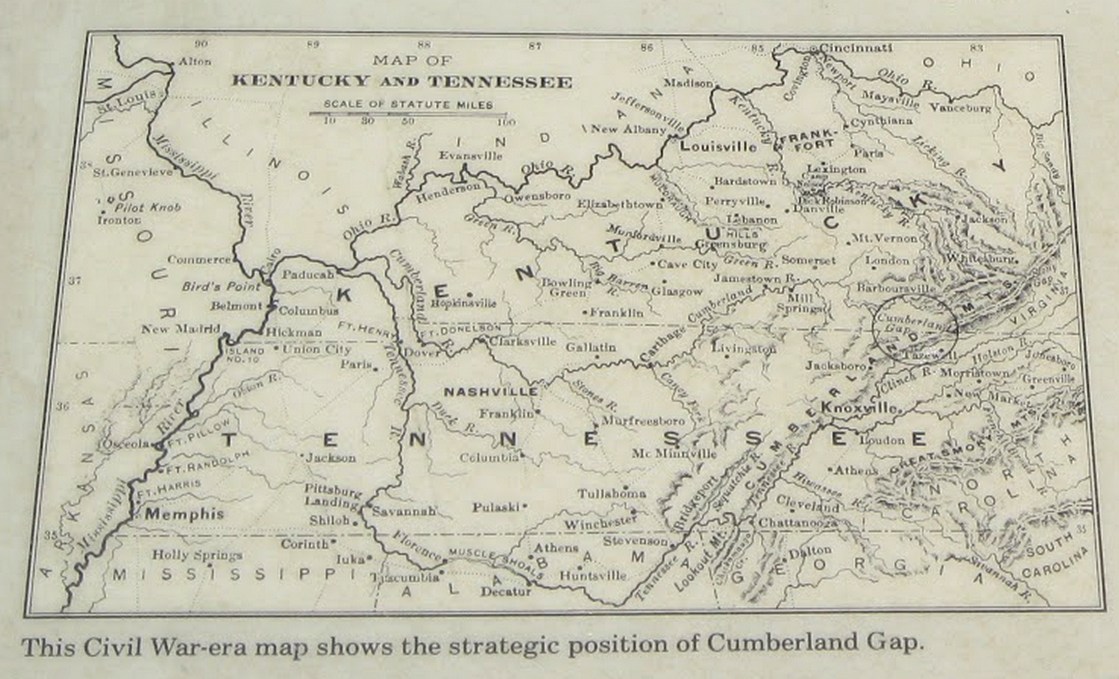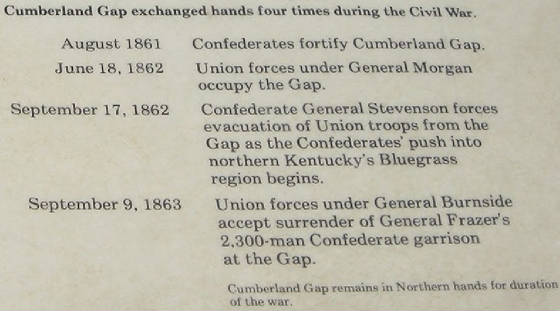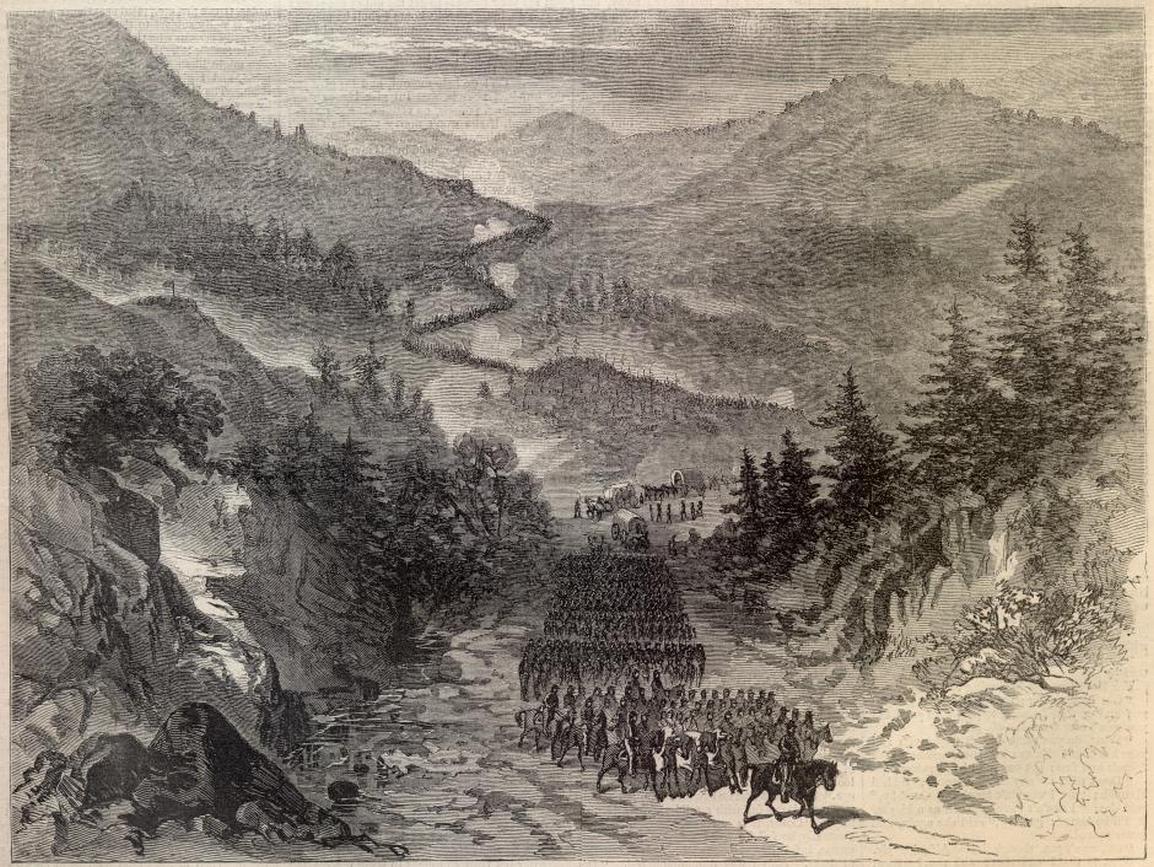|
Cumberland Gap
| Cumberland Gap Map |

|
| Map of the Cumberland Gap |
Waiting for the Battle That Never Came...
"We want to fight! We waited and waited! Then at 4 p.m. we were informed that we were prisoners of war."
Major B. G. McDowell while serving the Confederate army in the Cumberland
Gap
Introduction
While assigned to defend
the Cumberland Gap, Confederate General John W. Frazer, commanding, without the slightest hint of resistance
to the enemy and absent a single attempt to evade the foe, surrendered his entire command of over 2,000 men to Union
General Ambrose E. Burnside, including several hundred North Carolina soldiers, on September 9, 1863: 58th North Carolina,
4; 62nd North Carolina, 442; 64th North Carolina, 288, for a grant total of 744 North Carolina troops captured and sent
to Union prisons for the remainder of the Civil War.
| Cumberland Gap Civil War History |

|
| North Carolina Troops suffered heavy losses while in the Cumberland Gap |
| The prized Cumberland Gap in Civil War |

|
| How important was the Cumberland Gap during the Civil War? |
Casualties
Major B. G. McDowell, 62nd North
Carolina, stated that "When I was told by General Frazer that I had been surrendered, and that I and my regiment were prisoners
of war my indignation and that of my regiment knew no bounds. I informed him that I would not be made a prisoner of war that
it took two to make such a bargain as that under the circumstances, and that he could not force me to do so. Sharp words were
exchanged, and I called up all of the Sixty-second Regiment who were willing to take their lives in their hands and all of
the other commands in the Gap who were willing to join us, and said to them, "If you will go with me we will go out from
here, and let consequences take care of themselves."
Captain B. T. Morris, 64th North
Carolina, wrote that: "The Sixty-fourth was at that time much reduced in number. The officers were sent to Johnson's Island
and the privates to Camp Douglas on December, 1863. The number
of non-commissioned officers and privates belonging to the Sixty-four. So, while the Sixty-fourth North Carolina Regiment
can not boast of battles fought, or deeds of daring, yet its career was one of hardship and endurance, always ready to act
promptly at every command. A number of good men were lost, killed by bushwhackers and concealed enemies. There were, however,
several officers and some privates who would not surrender and made good their escape at Cumberland Gap
with Major B.G. McDowell, of the Sixty-second North Carolina, through the mountains and again went into active service. The
total surrendered so shamefully by General Frazer at Cumberland Gap was 2,026 prisoners,
12 pieces of artillery, and great stores of provisions and ammunition and quartermaster supplies."
While the 58th North Carolina
Troops had only 4 of its troops in the area captured, the bulk of the unit had already been reassigned to Big Creek Gap,
near Jacksboro, Tennessee, on outpost duty conducting picketing in the vicinity, including several passes of the Cumberland
Gap. The regiment also made several expeditions into Kentucky to ascertain and strike the enemy as circumstances
permitted. According to Colonel John Palmer, 58th North Carolina, commanding, the 58th was forwarded and fought at Chickamauga,
September 18-20, and suffered over 50% casualties of the number carried into action on September 19. Casualties totaling 161,
were killed, 46; wounded, 114; missing, 1 (missing was POW). An earlier after battle report indicated 39 killed and 121
wounded at Chickamauga, but in a revised report 7 soldiers were listed as mortally wounded and moved from wounded
to killed category.
In late December 1862, while guarding bridges and railroads in East Tennessee, three poorly armed companies (295 soldiers) of the 62nd North Carolina Regiment were captured
by a Union cavalry force of 3,000. The
62nd continued to serve and fight in East Tennessee until 442 of its men were surrendered to Union forces in
the Cumberland
Gap on September 9, 1863, by General Frazer, who many consider a coward for not fighting
nor trying to evade capture, but as many as 200 soldiers from the 62nd evaded capture and in April 1864 the unit mustered
178 men in Asheville. The bulk of the fighting at the Battle of Asheville one year later, April 6, 1865, and just three days prior to Lee surrendering to
Grant, was shouldered by the remaining 175 steadfast warriors who formed the ranks of the depleted unit for its
final mustering.
| Cumberland Gap was an important supply route |

|
| Civil War Cumberland Gap Map |
| Why all the fuss about one location on the planet? |

|
| Cumberland Gap was vital to both Union and Confederate armies during the Civil War |
The Old Wilderness Road cutting through the Gap was a natural invasion
route. For the Confederacy, it led to the rich Kentucky bluegrass country to the north. For the Union, it led to the Northern
sympathizers of East Tennessee, and to an opportunity to cut rebel supply lines. In late summer of 1861, the Confederacy seized
the Gap and made it the eastern anchor of a defense line extending to the Mississippi River. Brigadier General William Churchwell
was placed in command, and fortified the garrison during the fall of 1861. He built seven forts on the north facing slope,
and cleared the mountains of all trees within one mile of each fort. The Confederate forces were already stretched and were
also desperately needed in other areas.
Union Brigadier General George W. Morgan soon arrived to take possession
of the Gap. The 20,000 men under his command began building nine south-facing batteries to repel an invasion. "But none came."
The Confederates under Lt. Gen. Kirby Smith flanked the Gap with a force of 12,000 men and moved into Kentucky,
severing Morgan's supply line. Without food and still fearing an attack, General Morgan boldly led his men north through enemy
territory to safety.
The Confederates returned to the Gap, cleared up the mess Morgan and his
men left behind, and strengthened the forts. Many skirmishes took place, as Unionists from Tennessee raided the garrison.
In September 1863 a Union force under Maj. Gen. Ambrose E. Burnside moved toward the Gap. On September 7, the Yankees destroyed
provisions stored at the Iron Furnace. Burnside also deceived the Confederate commander, Brig. Gen. John W. Frazer, into believing
that his force was much larger. Believing his Confederates to be outmanned, and short of provisions necessary for a long siege,
Frazer surrendered his garrison on September 9.
| General Burnside commands the Cumberland Gap |

|
| Union Army invades Cumberland Gap in September 1863, Harper's Weekly, October 10, 1863 |
"Lining up along the Harlan Road, the Confederates were amazed to see the
small force to which they had surrendered." The Gap remained in Union hands until the end of the war. Except for a garrison
inspected by Lt. Gen. Ulysses S. Grant in January 1864, when he labeled the Cumberland Gap the "Gibraltar of America," there
was little excitement. Meanwhile, the war fought to its end in the South and East. (See also: Surrender of the Cumberland Gap and Kentucky Civil War History.)
By the end of the war the Gap had changed hands four times, yet no major
confrontation took place here.
Sources: Official Records of the Union and Confederate Armies; National Park Service
Recommended Reading: East Tennessee and the Civil
War (Hardcover: 588 pages). Description: A solid social, political, and military
history, this work gives light to the rise of the pro-Union and pro-Confederacy factions. It explores the political developments
and recounts in fine detail the military maneuvering and conflicts that occurred. Beginning with a history of the state's
first settlers, the author lays a strong foundation for understanding the values and beliefs of East Tennesseans. He examines the rise
of abolition and secession, and then advances into the Civil War. Continued below...
Early in the conflict, Union sympathizers burned a number
of railroad bridges, resulting in occupation by Confederate troops and abuses upon the Unionists and their families. The author
also documents in detail the ‘siege and relief’ of Knoxville. Although authored by a Unionist, the work is
objective in nature and fair in its treatment of the South and the Confederate cause, and, complete with a comprehensive index,
this work should be in every Civil War library.
Recommended Reading: War at Every Door: Partisan Politics and Guerrilla Violence in East Tennessee,
1860-1869. Description: One of the most divided regions of the Confederacy, East
Tennessee was the site of fierce Unionist resistance to secession, Confederate rule, and the Southern war effort.
It was also the scene of unrelenting 'irregular,' or guerrilla, warfare between Union and Confederate supporters, a conflict
that permanently altered the region's political, economic, and social landscape. In this study, Noel Fisher examines the military
and political struggle for control of East Tennessee from the secession crisis through the
early years of Reconstruction, focusing particularly on the military and political significance of the region's irregular
activity. Continued below...
Fisher portrays
in grim detail the brutality and ruthlessness employed not only by partisan bands but also by Confederate and Union troops under constant
threat of guerrilla attack and government officials frustrated by unstinting dissent. He demonstrates that, generally, guerrillas
were neither the romantic, daring figures of Civil War legend nor mere thieves and murderers, but rather were ordinary men
and women who fought to live under a government of their choice and to drive out those who did not share their views.
Recommended Viewing: The Civil War - A Film by Ken Burns. Review: The
Civil War - A Film by Ken Burns is the most successful public-television miniseries in American history. The 11-hour Civil War didn't just captivate a nation,
reteaching to us our history in narrative terms; it actually also invented a new film language taken from its creator. When
people describe documentaries using the "Ken Burns approach," its style is understood: voice-over narrators reading letters
and documents dramatically and stating the writer's name at their conclusion, fresh live footage of places juxtaposed with
still images (photographs, paintings, maps, prints), anecdotal interviews, and romantic musical scores taken from the era
he depicts. Continued below...
The Civil War uses all of these devices to evoke atmosphere and resurrect an event that many knew
only from stale history books. While Burns is a historian, a researcher, and a documentarian, he's above all a gifted storyteller,
and it's his narrative powers that give this chronicle its beauty, overwhelming emotion, and devastating horror. Using the
words of old letters, eloquently read by a variety of celebrities, the stories of historians like Shelby Foote and rare, stained
photos, Burns allows us not only to relearn and finally understand our history, but also to feel and experience it. "Hailed
as a film masterpiece and landmark in historical storytelling." "[S]hould be a requirement for every
student."
Recommended
Reading:
Hardtack & Coffee or The Unwritten Story of Army Life. Description: Most histories of the Civil War focus on battles and top brass. Hardtack and Coffee
is one of the few to give a vivid, detailed picture of what ordinary soldiers endured every day—in camp, on the march,
at the edge of a booming, smoking hell. John D. Billings of Massachusetts enlisted in the
Army of the Potomac and survived the hellish conditions as a “common foot soldier”
of the American Civil War. "Billings describes
an insightful account of the conflict – the experiences of every day life as a common foot-soldier – and a view
of the war that is sure to score with every buff." Continued below...
The
authenticity of his book is heightened by the many drawings that a comrade, Charles W. Reed, made while in the field. This
is the story of how the Civil War soldier was recruited, provisioned, and disciplined. Described here are the types of men
found in any outfit; their not very uniform uniforms; crowded tents and makeshift shelters; difficulties in keeping clean,
warm, and dry; their pleasure in a cup of coffee; food rations, dominated by salt pork and the versatile cracker or hardtack;
their brave pastimes in the face of death; punishments for various offenses; treatment in sick bay; firearms and signals and
modes of transportation. Comprehensive and anecdotal, Hardtack and Coffee is striking for the pulse of life that runs through
it.
Recommended Reading: The Loyal Mountaineers Of Tennessee (1888) (Hardcover) (426 pages) (Kessinger Publishing, LLC) (June 2, 2008).
Description: This book
defines the importance of East Tennessee and its residents to the Union cause during the
Civil War. The author begins with early history of East Tennessee and the events which led
to the War Between the States. He continues by describing local people and events that contributed to the decision to remain
loyal to the United States. Continued
below...
The events of the War as they involve East Tennessee are detailed, including
important meetings and battles such as Carter's Raid and the siege of Knoxville. The text is enhanced with illustrated portraits
of East Tennessee individuals who contributed to the Civil War effort. Originally written and published in 1888, this reprinted
edition is accompanied by a complete index. This book is a valuable addition to both the Tennessee historian and the Civil
War buff.
Try the Search Engine for Related Studies: Cumberland Gap Map Kentucky, East Tennessee Photo,
Pictures, Civil War Surrender Cumberland Gap, Experience The Cumberland Gap, Western North Carolina and the Cumberland Gap
History, Photos, Picture Details
|

